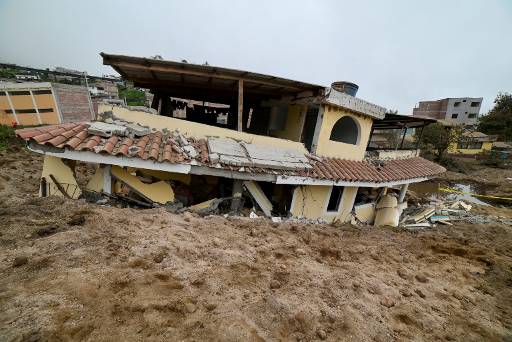Rescuers looked for more than 60 individuals reported missing on Monday after a landslide in southern Ecuador that at least seven people died in was caused by months of heavy rain.
In the village of Alausi, located in the province of Chimborazo, about 300 kilometers (180 miles) south of Quito, the mudslide occurred overnight on Sunday into Monday, burying scores of homes and wounding 23, according to officials.
Residents were shocked and many were in tears as they waited for news Monday as rescuers combed through the rubble looking for survivors trapped beneath twisted metal sheets and splintered tree trunks.
“Five are buried here,” Manuel Upai, a 40-year-old laborer, told AFP, referring to relatives of his as he stared at the muddy ground
The avalanche that destroyed roads and shut down three schools also hit several public buildings in Alausi, a hamlet of about 45,000 people surrounded by lush hills.
“I managed to escape with about 15 minutes to spare,” survivor Jose Agualsaca told local TV network Teleamazonas, saying he was rushing to get things out of his house before the mud came.
Guillermo Lasso, the president of Ecuador, announced on Twitter that firefighters from nearby regions had raced to the community to aid those affected by the disaster.
He exhorted everyone to leave the damaged areas.
To aid in the rescue operations, the government called upon the national police, military forces, health ministry, and Red Cross.
“We have activated temporary accommodation and mobilized sleeping kits for those that have lost their homes,” said a government statement on Twitter
– Landslides, floods –
According to the SNGR risk management secretariat, since the year’s beginning, torrential rains in Ecuador have killed 22, destroyed 72 dwellings, and damaged more than 6,900 homes.
Around 1,000 hazardous occurrences, including landslides and flooding, have been brought on by the downpours.
Following earlier landslides, the region that was devastated on Sunday has been placed in a yellow warning risk zone since February.
Local officials assigned the earthquake a magnitude of 6.5, and it resulted in 22 landslides that blocked roads in the provinces of El Oro and Azuay.
Following that, the government proclaimed a two-month state of emergency in 13 of the 24 provinces of the nation, enabling for the redistribution of economic resources to the impacted regions.
Due to concerns that a significant oil pipeline may have been harmed by the collapse of a bridge, severe rains in February forced the country to cease oil pumping for five days in order to conduct safety assessments.
The rainy season in Ecuador’s Andes valleys can run from October to May.






